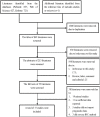Stromal Myofibroblasts Are Associated with Poor Prognosis in Solid Cancers: A Meta-Analysis of Published Studies
- PMID: 27459365
- PMCID: PMC4961396
- DOI: 10.1371/journal.pone.0159947
Stromal Myofibroblasts Are Associated with Poor Prognosis in Solid Cancers: A Meta-Analysis of Published Studies
Abstract
Objective: Published studies have evaluated the impact of stromal myofibroblasts on prognosis in solid cancers. However, the results of these studies remain controversial. We therefore performed a meta-analysis to address this issue.
Methods: The PubMed, ISI Web of Science and Embase databases were searched through November 30th, 2015 by two investigators, and a total of 17 studies that contained 2606 patients were included. Stromal myofibroblasts were quantified in solid cancers using α-smooth muscle actin staining. Pooled Odds Ratio with 95% Confidence Intervals were calculated, and publication bias was analyzed.
Results: The results of this study suggest that in solid cancers, a high density of stromal myofibroblasts is significantly associated with poor 3- and 5-year overall survival (pooled odds ratio (95% confidence interval): 1.33 (1.10-1.60) for 3-year overall survival and 1.68 (1.22-2.32) for 5-year overall survival). In addition, a high density of stromal myofibroblasts also predicted poor 3- and 5-year disease-free survival (1.30 (1.05-1.60) for 3-year disease-free survival and 1.36 (1.01-1.83) for 5-year disease-free survival). However, stromal myofibroblasts were not associated with 3- and 5-year cancer-specific survival. No publication bias was found for all analyses.
Conclusions: The results of this study suggest that a high density of stromal myofibroblasts is associated with poor survival in solid cancers. More studies were required to investigate the prognostic value of stromal myofibroblasts in different types of solid cancers.
Conflict of interest statement
Figures





References
-
- Jayne DG. The molecular biology of peritoneal carcinomatosis from gastrointestinal cancer. Ann Acad Med Singapore. 2003;32: 219–225. - PubMed
-
- Bianchi G, Borgonovo G, Pistoia V, Raffaghello L. Immunosuppressive cells and tumour microenvironment: focus on mesenchymal stem cells and myeloid derived suppressor cells. Histol Histopathol. 2011;26: 941–951. - PubMed
Publication types
MeSH terms
Substances
LinkOut - more resources
Full Text Sources
Other Literature Sources
Medical
Miscellaneous

